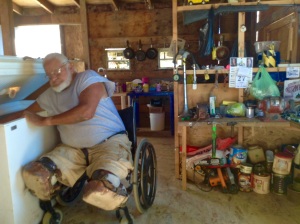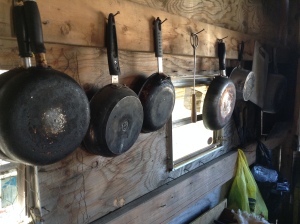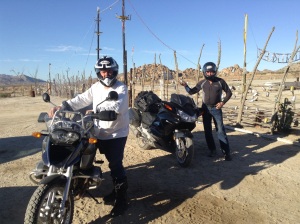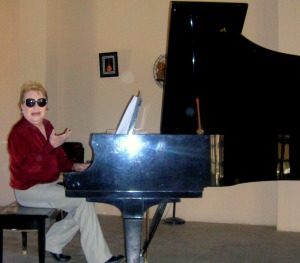Imagine……..Desert sunsets dressed in purple, red and gold….as coyotes sing their evening song!
The second full moon of this trip hung low in the night sky, darkening previous nights star-filled skies. Coyotes forlorned cries, answered by the softened cry of a distant female, filled the unexpected crisp air of a sudden fall season. It had thankfully replaced the humidity-sodden closeness of the past summer nights.
Tractor trailers, rumbling downhill across the twenty-two mile stretch of unpaved, rock strewn, desert road, sporadically broke the night’s silence, as they hit their spark arrestors, slowing their descent from the mountainous road, to avoid flattening Coco’s Corner.
As sleep eluded me……and Tony dozed quietly beside me…..Coco…as he had done for the last twenty-five years…..snored softly in the plywood bed he had built discreetly in a corner behind his desert bar.
After starting his journey in Ensenada and passing through Chipala, the man walked onto this property on December 27, 1990, arriving at 4:30 in the afternoon. If asked, he will look up at his clock, think a minute and tell you the exact number of years, months, hours and minutes he has lived in his chosen world.
According to his own words, “He had ten pesos in his pocket and the shoes on his feet when he declared this land his own.” He paid nothing for his small piece of barren desert that only had a donkey trail leading to it from some far away place. Despite seven robberies and the Government trying to throw him out after his first five years, he has remained the proprietor of Coco’s Corner to this very day.
Over the years he designed his decor to suit his lifestyle and his own personal tastes. His four-walled, muti-material residence and business are the center point of his property. Fences, comprised of empty beer cans, tree stumps and branches, greet you as you come over the hill. A tree trunk adorning an old electric typewriter and a fax machine grace entrance to the dirt floor, three-walled patio. From the patio ceiling hang hundreds of pairs of guests underwear, all signed and dated. License plates, doll heads, religious necklaces and a thousand other trinkets fill every tiny crevice of the walls and ceiling. Old campers and two outhouses, gaily painted, crisscross the surrounding property. A circle of artfully placed toilets showcasing the cab of a tractor complete the picture.
He has done it alone. He has done it to spite the loss of both legs, one to an accident and one to diabetes. He has never had any neighbors but, he has countless friends and visitors from around the world, people who never forget him and never see him need for anything.
Coco runs a simple business. He sells beer. You are expected to help yourself from his non-freezing freezer, behind his counter. Should it be your first visit and you are not aware of this practice, he hands you your first one and informs you of the proper procurement of the second one. No tab is run. None are needed. When you leave he asks you what you had and tallies what you owe, without paper or pencil.
As we wiled away the afternoon with a cold beer at Coco’s one community table, two young construction workers from the road project pulled onto the property. Quiet words were passed between the men and Coco. The men helped themselves to a beer and joined us at the table. Coco appeared carrying a very large knife, idled by us, playfully jabbing Tony’s ankle with the tip of the knife…..laughing at the concerned look on Tony’s face…..and assured us all that he would return shortly. He fired up his uniquely-modified ATV and disappeared into the desert, only to return twenty minutes later with a large hunk of cactus.
Without any words, we all sat at the table, our toes dug into the sand with anticipation, sipping our beers and watched as he artfully carved the heart out of the cactus piece. A brief inspection, a look of satisfaction and an authoritative command to the young man to go and fill the milk jug with water, broke the silence at the table.
He turned his rugged, weather-beaten face to me and said, “Garambullo, five-point cactus, not six point, five point, you understand, Lady? Boy hurts when he pees. You put heart in water, wait twenty-four hours, drink whole gallon, no more hurt when you pee. You understand? You have sick stomach, I cut you piece of my Mesquite tree, boil it in water, make you better. Make cancer better, too.”
Five point Six point
I assured him I did. What I understood best was that I had just met the Mexican curandero, or village healer, that I had written about in my book many years before. My character is no longer fictitious to me. He is a real person in an outrageous place called Coco’s corner.
The two young men paid for their beers and left Coco’s happily smiling, clutching their gallon jug.
Coco tells you that for the price of one beer, you can camp for free. He proudly announces that he has never charged anyone to stay the night. Before he goes to bed, he arrives unexpectedly on his ATV and visits you to say good-night. He offers you one of his little campers ‘because they are more comfortable than what you have’ and he asks if you need power.
He lets you know that he is going to run his generator for one hour because he watches ‘a half movie a night’and then he motors the fifty feet home and parks his ATV where his customers will sit in the morning. Exactly one hour later, the generator is silent and all lights are out. All is well and tomorrow is another day.
In the morning he offers you coffee and then, pointing to the corner in his makeshift kitchen, he commands, “Come back here!” As you obediently follow him, he whips his wheelchair around and shows you to his stove, upon which a teakettle is boiling water. He then moves toward a grocery-filled table and routes out the instant coffee, pushes himself away and tells you to make it yourself. It is obvious that he has done all of this before.
Once you settle at the table with your cup, he hands you a giant book. He has drawn a small picture of your vehicle on the next available line “and he hands you a pen. He insists that you write your information in the entire space he has allotted to you. Nothing less than full is acceptable. He has a completed book for each year he has been in business.

Our little VW picture is really cute and our name, address and business card almost filled the whole space. He would not take his pen back until I filled the two remaining empty lines, declaring that I was nothing but trouble. He demanded to speak to Tony, waving his hand in disgust towards me.
As the sun rose in the early morning sky, Coco’s guests for the day started to arrive. Before 8:00 a.m., probably fifteen people had stopped by……international bicyclists, motorcyclists…who just dropped down from San Felipe to say hello….truck drivers, travelers trying the infamous road for the first time and a variety of other ‘just folks’.
Tony missed most of the gaiety because Coco needed a new little light installed next to his bed and he thought Tony ‘was just the man to do it!’ Coco made this clear by demanding “YOU! Ca Mere, I need you,”while pointing at Tony to follow him.
His real name is Jorge Enrique Coral Sandes. He is 78 years old. He is a man of his own means. He is a man who threw another man off of his property who claimed to be the rightful owner. He is man who invited the authorities to be called because he had been on the land five years, paid his taxes to the Governor…of whom he had a picture of with his arm around him….and then introduced him to his middle finger. He is a man whose wife and two children walked away from him at age twenty-one and he never saw them again. He is a man who said good-bye to both of his legs. He is a man who sells a cold beer, for a fair price, to weary travelers who travel the desolate desert highway and then throws in a free campsite. He is a man amongst coyotes and a bunch of other things, but most of all, amongst his countless array of world-wide friends.































